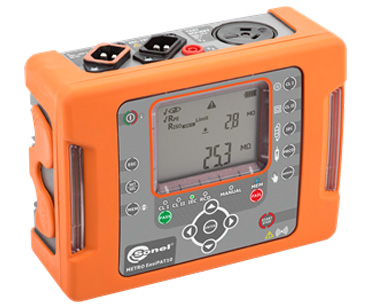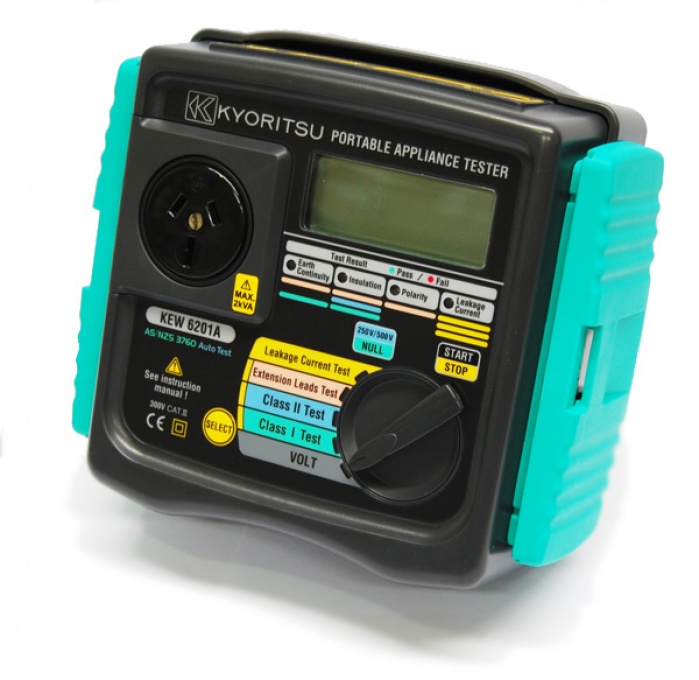In the $1,000 – $2,000 range today, we review a tester from a newcomer to the PAT market in Australia – the Sonel EasiPAT.
Although little, this tester packs a couple of surprises that we did not expect, so let’s see what we mean:
The unit is supplied in a soft carry bag that is purpose built to sit around the neck and provide access to the tester to carry out testing, zip up sides allow for the tester to effectively live snugly in this without needing to be removed. Simply unzip the top of the bag to access the tester and then unzip the sides to allow access to the test sockets or download port. A basic memory, mains and battery operation as well as a printer capable!
Used as a basic tester, this is very quick testing. Easy to see green and red lights indicate a pass or fail as well as numerical values on the screen and auditable tones which clearly identify the results of testing. This would have to be the stand out when it comes to ensuring you know the result of a test. The battery is charged whilst in use and uses a simple IEC test lead for the charging, making this a very easy and cheap to replace cable if lost or damaged.
A great safety feature that we have not seen before now is the addition of flashing lights prior to the leakage test (the one that makes things go). This helps to identify that something is going to happen and that you as the competent person acknowledge the device under test will start.
With automated test and a manual test mode there are a lot of options here. The auto test mode is pre-programmed with the required tests to meet ASNZS3760 and the manual mode will allow you to perform additional one-off tests as required.
So let’s have a look at the tests that this PAT can carry out.
As usual we will start with the earth bond test, which is where things become a little different. Sonel have decided to do something unique and test at not only 200milliamps but have put a 10Amp earth test here. This means that not only can you simply be compliant, you can now test for safety with a handheld PAT.
This takes us from a 200milliamp test to a 10,000milliamp test and starts to make us wonder what other hidden gems there are in this little tester.
Insulation resistance works as can be expected with both 250V and 500V selectable.
Polarity testing is also in place as would be expected and has been nicely incorporated into the auto test modes where required. A downside to the Automatic tests is that when testing a powerboard you do have to go through the full sequence for each socket instead of simply carrying out the earth test. This can be worked around by carrying out manual earth tests prior to using the automated code.
For PRCD testing, both 10mA and 30mA PRCDs may be tested at both normal trip currant and 5x the rated current. Additional tests in the PRCD test code include earth bond, leakage and the elusive polarity that we did not see in the Metrel DeltaPAT. Trip times and “ramp up”current tests are also measured and recorded to ensure full compliance can be seen – does this make sense?
An additional free software that allows for downloading of the data from unit and exporting to CSV does give this an extra boost. With most software for PATs ranging from $500-$1,200 we see this as a real saving. Sonel have also announced they are working on an Application to be able to download the data to android mobile devices, however this is still in Beta testing and may be some time away.
We would like to point out that the application would be a welcome addition as the current data input is extremely basic and could use the upgrade.
ADDITIONAL FEATURES
This PAT can be easily connected to a little WiFi printer allowing for small labels to be printed. When printed the labels can show the results of the test on them with numerical values and if an item fails the failing reason is highlighted to show why – this is a very useful feature when the unit is handed to a repairer.
Q: Does it enable a testing person to comply with all the requirements of ASNZS3760?
A: YES
Q: Is it a safety tester or compliance tester only?
A: Safety and Compliance
Q: Value for money
A: Great
4 out of 5 stars
With the addition of a better data entry and an option to complete multiple earth tests without having to go through the whole full test sequence each time, this could be an almost perfect hand-held tester.


